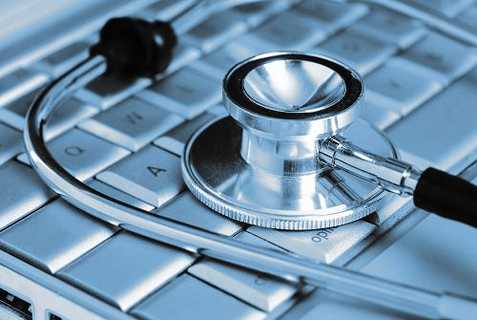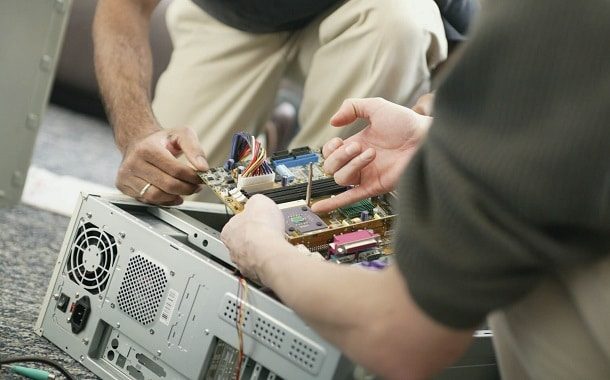How Much Does PC Repair Cost?
Last Updated on February 20, 2024
Written by CPA Alec Pow | Content Reviewed by ![]() CFA Alexander Popinker
CFA Alexander Popinker
PCs require maintenance and repairs to keep them running efficiently. As a computer owner, knowing the average cost of common PC repairs can help you budget for inevitable issues and decide when to repair vs. replace your device.
In this guide, we’ll explore the typical pricing for PC diagnostics, hardware repairs, software troubleshooting, virus removal, and more. Read on to learn what influences repair costs and how to get the most value from computer repair services.
Highlights
- Budget $200 to $500 per repair on average for desktop/laptop hardware replacements, software troubleshooting, and virus removal.
- Diagnostic fees, repair complexity, computer model, shop rates, and emergency service all impact the total pricing.
- Use warranties, learn basic DIY fixes, compare quotes, and find certified technicians to minimize expenses.
- Prioritize critical repairs and proactive maintenance to avoid high fees for serious failures down the road.
How Much Does PC Repair Cost?
The minimum cost for basic PC repairs like memory upgrades and peripheral replacements is typically $50-$150, while involved repairs like liquid damage recovery or ransomware removal from networked systems can cost over $5,000 at the high end.
On average, most common PC repairs like hardware replacements, operating system reinstallation, and virus removal fall within the $200 to $500 range.
Diagnostic fees typically range from $50 to $150 per hour. This covers a technician evaluating your computer, testing components, and determining required repairs. PC repair pricing varies widely based on the specific service needed.
For hardware repairs, laptop screen replacements average $200 to $900 depending on screen size, resolution, and labor involved. Swapping out failed hard drives costs $100 to $600 based on HDD/SSD type, storage amount, and data migration needs.
Motherboard repairs average $300 to $700 while fixing cooling fans stays under $150 in most cases.
Software repairs like OS reinstallation run $100 to $300. Virus removal averages $200 to $600 for individual computers while advanced ransomware removal from networked systems can cost thousands.
Data recovery for crashed hard drives starts around $300 for basic recovery but climbs to $5,000 or more for extensive recovery from severe drive failures.
Overall, most individual PC repairs like hardware replacements and software troubleshooting fall within a $200 to $500 range per repair/service. However, costs can easily exceed $1,000 when multiple components need replacement or highly complex software issues require troubleshooting.
GetMulberry notes that a PC repair shop may charge as follows:
- Blue or blank screen: Around $150
- Slow overall performance: Around $210
- Inability to turn the machine on: Around $310
- Grinding sounds in hard drives: Charges starting from $1,000
- MacBook Pro screen repair: $455-$755 depending on the generation and extent of damage.
According to HomeGuide the costs of PC repair are:
- Complete Tune Up & PC Repair: $150
- Diagnostic Testing: $40
- Laptop Hardware Repair: $30+ per component
- PC Hardware Repair: $20+ per component
- Software Installation: $10 per install
- Laptop Rental: $50
- Mobile Repair: $35–$40 for diagnostics and testing
- Data Recovery: $100+
- Wireless Network Installation: $100+
- PC Tuneup: $70
- Virus Removal: $70
- Operating System Formatting: $150
Computer Repair Las Vegas, Inc. has listed the following costs on its website:
- Labor only: $149
- Labor plus parts: $149 + parts
- Labor plus $4 part: $149 + $4 part
- Per hour: $124/$99 when possible
- Total average: $190
- Pickup charge: $25
Overview of Common PC Repair Needs
Desktops and laptops rely on several components working together smoothly, from the CPU and RAM to operating systems, cooling fans, and peripherals. With prolonged use, some parts may malfunction or fail while software can become corrupted by viruses, bugs, and outdated drivers. Common PC repair needs include:
Hardware Failure and Replacement
- Motherboards ($300 to $700 for repairs) – The main circuit board fails, often needing professional soldering skills to fix.
- Power supplies ($50 to $250 to replace) – Insufficient wattage or crashes indicate a faulty power supply unit.
- Cracked screens ($200 to $900 for repair/replacement) – Drops and impacts damage LCD displays.
- Overheating CPUs ($100 to $300 for re-pasting sinks) – Fans and heat sinks lose efficiency, requiring new thermal paste or pads.
- Hard drive failures ($100 to $600 for replacement) – Crashes and bad sectors indicate a dead or dying hard drive.
- Bad RAM ($50 to $200 for new DIMMs) – Crashing and freezing can occur when memory modules fail.
- Liquid spills ($300 to $2,000+ for part replacements) – Drinks/spills can short circuit internals requiring many new parts.
Software and Performance Issues
- Sluggish performance ($100 to $300 for OS reinstalls, upgrades) – Systems slow over time as registries and files become cluttered.
- Corrupted files ($250 to $600 for software troubleshooting) – Important files and applications fail to open or function correctly due to underlying software issues.
- Program crashes/freezes ($100 to $500 for software repairs) – Apps unexpectedly shut down or freeze, impairing usability.
- OS failures ($150 to $400 for reinstallation) – Failed Windows or MacOS updates or corrupt system files make reinstalling the operating system necessary.
Security Threats and Data Loss
- Virus/malware removal ($200 to $800+ for individual PCs, $5000+ for networks) – Infections damage files, corrupt software, enable cybertheft, and impair performance.
- Data recovery ($300+ for personal files, $3000+ for system recovery) – Failed drives, partitions or deletions require specialist data recovery to salvage lost files.
- Hacks/breaches ($1000+ for incident response) – Successful cyberattacks inflict hardware or software damage requiring expert assessment and remediation.
Regular maintenance and repairs ensure PCs survive beyond their warranty and run efficiently for years of reliable service. Neglecting issues leads to total failure, making proactive repairs well worth the investment.
You might also like our articles on the cost of laptop hinge repair, hard drive replacement, or laptop screen replacement.
Factors Affecting the Cost Range for PC Repairs
Several factors determine where your computer repair pricing will fall within that broad $200 to $500+ range:
Desktops vs Laptops
For similar issues, laptop repairs often cost $100 to $300+ more than desktops. Laptops cram components into tight spaces, often requiring nearly complete disassembly for access. Many parts are proprietary and must be sourced from the OEM. Labor time is higher as well.
Repair Complexity
Simple fixes under $200 include peripheral replacements like mice, keyboards, or WiFi cards. More complex fixes over $1000 include motherboard component replacement, data recovery from mechanically damaged drives, and ransomware removal.
Service Location
On-site repairs cost $50 to $150+ more with technician travel time and service call fees. Shops have lower overhead to offset.
Computer’s Age and Model
Vintage PCs from the 2000s with easily found used parts cost less to repair. Newer laptops require current proprietary parts from the OEM, raising prices.
Shop Rates
Authorized OEM providers charge $50 to $200+ more thanks to direct supply chains but offer greater expertise. Small shops boast lower rates but variable quality.
Emergency Repairs
Emergency or rush repairs have premium rates up to double normal pricing, given overtime labor costs. Avoid these fees with proactive maintenance.
Customer Technical Expertise
Customers who can self-diagnose basic issues before taking computers into the shop save significantly on diagnostic and troubleshooting fees. Learn to spot failing hardware like bad memory or CPUs overheating.
Considering these factors helps gauge if your quote falls within the typical local rate for a given service. Ask providers to explain charges so you understand what labor and parts make up the total price.
Tips for Reducing PC Repair Costs
 Follow these tips to minimize expenses whenever possible:
Follow these tips to minimize expenses whenever possible:
- Use warranty coverage for manufacturer defects within the original warranty period to get free repairs.
- Learn DIY fixes for basic maintenance like dusting fans or reseating RAM to avoid hourly shop fees.
- Clean up software issues yourself using system utilities before taking machines in for deeper troubleshooting.
- Compare repair quotes and check reviews to find reliable professionals offering competitive pricing.
- Ask about discounts like multi-computer or student/senior reductions to lower your bill.
- Book repairs in advance instead of paying emergency fees for quick turnaround.
- Prioritize critical repairs and tolerate some minor issues to avoid unnecessary costs.
How to Choose the Right Repair Shop for Your PC
Finding a skilled and affordable repair technician you can trust helps ensure you get your money’s worth from PC repairs. Consider these tips when choosing a provider:
- Search for local shops with expertise in your computer brand and model. Authorized repair centers have direct access to original parts.
- Check reviews on Google or Yelp to verify quality of service and fair pricing from past customers.
- Look for certified technicians indicating solid training and expertise in handling all types of PC repairs.
- Ask about warranties on work performed so defective parts or repairs get redone at no added cost.
- Inquire if they offer free diagnostics or discounts on repairs when you greenlight suggested fixes.
- Request an itemized repair quote before approving work so potential charges are clear upfront.
Final Words
Investing in timely PC repairs reduces future downtime and costs, keeping your computer running smoothly for years to come. Understanding typical pricing helps you plan budgets and make informed decisions when maintenance needs arise.
Frequently Asked Questions
How long does a computer repair last?
With proper ongoing maintenance, most general hardware repairs and software troubleshooting can extend your computer’s life by 2-3 years or more. But if underlying problems like outdated components aren’t addressed, repairs may only provide a temporary fix before further issues arise.
Is it cheaper to repair or replace a PC?
For older PCs, replacement costs less than repairing multiple components. But for newer computers, repairing isolated issues like a failed hard drive often costs less than buying a comparable replacement machine. Consider repair for minor problems and replacement for systemic failures.
What to do before bringing a PC to repair?
Back up critical data, remove peripherals and accessories, delete private/sensitive files, and disable passwords. This protects your data during repairs, avoids lost devices, and lets technicians access necessary systems. Describe issues clearly so they know where to focus diagnostic testing.


My brother’s computer has a virus on it and he has been trying to fix it. You mentioned that the repair man has tools and computers at his office that can be used to test and diagnose your PC. It seems that having a professional look at the computer could be beneficial. What kinds of test do they use?
Yes, a professional will be able to look for and remove viruses, but you will also get a check for mallware, spyware or intrusive software.